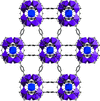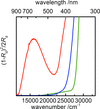issue contents
June 2017 issue

Cover illustration: The crystal structure of the opthalmic drug prednisolone acetate has been refined using the classical independent atom model (IAM), as well as by using the transferred electron-density parameters from an electron-density database. The results of the two refinements have been compared. Structure-property relationships have been described based on the calculation of electron-density-derived properties. See Shahid, Noureen, Choudhary, Yousuf & Ahmed [Acta Cryst. (2017), C73, 430-436].
research papers




























 journal menu
journal menu






























